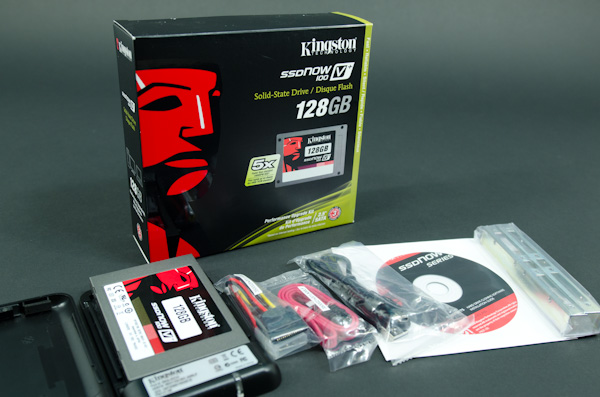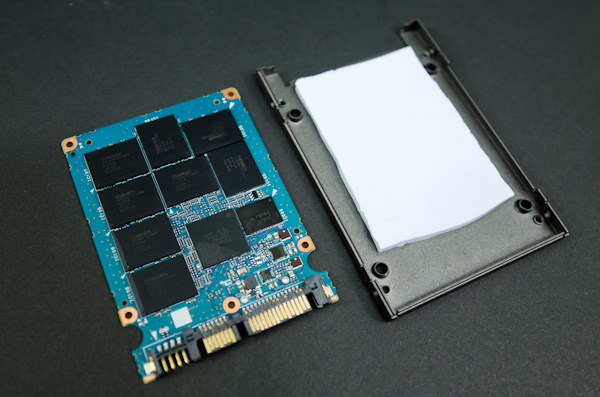Kingston SSDNow V+100 Review
by Anand Lal Shimpi on November 11, 2010 3:05 AM EST- Posted in
- Storage
- SSDs
- Kingston
- SSDNow V+100
Final Words
Kingston, like many of its competitors, desperately needs a simplified product lineup. On the one hand, Kingston has hedged its bets. With three different controller makers supplying hardware for its six SSDs, Kingston can't go wrong. However, the Toshiba powered SSDNow V+ spans the gamut from mediocre random write speed to chart topping performance in some of our workloads. The real world test results are strong enough for me to recommend the drive, however two things don't sit well with me.
First is the price. The V+100 commands a nearly $50 premium over competing SandForce drives. While I can understand paying some premium for Toshiba's name and hopefully reliability, that's a bit much. Compared to the RealSSD C300 the premium is negligible, so the complaint only applies as long as SandForce is in the running.

Kingston sells SSDs as both standalone drives or a part of an upgrade kit
The second issue is the overly aggressive garbage collection. Sequential performance on the V+100 just doesn't change regardless of how much fragmentation you throw at the drive. The drive is quick to clean and keeps performance high as long as it has the free space to do so. This is great for delivering consistent performance, however it doesn't come for free. I am curious to see how the aggressive garbage collection impacts drive lifespan. Kingston ships the V+100 with a 3-year warranty and to Kingston's credit I haven't had any other drives die as a result of wearing out the NAND. Even if the V+100 has higher effective write amplification than the competition, your usage model will determine whether or not you bump into it.
Toshiba is clearly close to knocking this one out of the park. There's a tangible improvement over the original V+ and the drive is clearly doing some things right. The V+100 isn't flawless, but it's finally in the list of drives to consider.
SandForce continues to be the sensible choice, at least in terms of performance per dollar for a boot/application drive. I am careful to mention it as a boot/application drive because if you start storing a lot of incompressible data on the drive (e.g. movies, music, photos) then SandForce quickly loses a lot of its performance advantage. Then you're left with Crucial's RealSSD C300 which delivers more consistent performance regardless of data, at the expense of lower steady state write performance. Without TRIM, the C300 can quickly get into a not-so-great performance situation.
If you don't want a SandForce drive and are running an OS without TRIM support, the V+100 is probably a better option than the C300 thanks to its aggressive garbage collection. I realize this isn't the simplest recommendation, but that's the reality of today's SSD market. There are a lot of great options, but nothing is absolutely perfect.











96 Comments
View All Comments
eckre - Saturday, November 13, 2010 - link
So this seems like a perfect drive for a RAID because of it's aggressive always on garbage collection would make up for lack of TRIM support. ?Am I correct? Thoughts?
JohnWPB - Saturday, November 13, 2010 - link
I have built probably 10 pc's in the last 2 yrs, and wonder if adding a SSD as a boot drive would be worth the effort.I see you guys making lots of comments, but as a newbie on SSD's, I would really like to see a thread on how to introduce a SSD to a system that has a bunch of SATA drives.
Exactly how does one go about installing Windows XP Pro? I imagine that I should disconnect my SATA drives and just hook up the SSD and then do a CD install?
Can programs like CasperXP ( mirror imaging program ), be used to do a mirror image backup from an SSD to a Sata drive ( C: boot drive SSD to D: mirror drive SATA ).
My apologies if this was posted in the wrong thread.
Out of Box Experience - Saturday, November 20, 2010 - link
QUOTE:Exactly how does one go about installing Windows XP Pro? I imagine that I should disconnect my SATA drives and just hook up the SSD and then do a CD install?
---------------------------------------------------------------------------------------------------------
You are correct as far as I can tell...
I just spent the past 2 days retesting the copy/paste speed of a Vertex 2 with the alignment tweak recommended by OCZ
There was no speed benefit resulting from the alignment of the partition as OCZ described
Copy and paste speed was still a miserable 3.6 megabutes per second
But just to be on the safe side, I will start using ONLY Intel SSD's with Windows XP
Anand says Intel controllers are alignment agnostic and should be the best for non-compressible data under XP
So, untill other SSD manufacturers start making alignment agnostic controllers that are capeable of doing a copy and paste faster than my 5400RPM laptop drive under XP, I think I'll just stick with Intel
(Better Flash Quality as well)
Ezekeel - Saturday, November 13, 2010 - link
Hi Anand,you noted that due to the aggressive garbage-collection this SSD will have a large write-amplification, so the flash will wear-out more quickly. What would happen when using this SSD with an OS that supports TRIM? Will TRIM support the internal GC and lead to a smaller write-amplification and thus a longer lifetime of the SSD?
mpx - Sunday, November 14, 2010 - link
Can you test how VMs behave on SSD? I understand it's partially there in synthetic IOPS and bandwith tests - that show what can you get max. from these drives. But "normal" load from multiple VMs should be different than normal load from a single OS, so drives that do good at normal load in current test migth be not performant under normal load of multiple VMs.This test with few VMs makes sense for larger drives (160, 256GB), as there just won't be enough place for multiple OSes on small drives. Also longevity becomes more important when you have few times larger load.
tecknurd - Sunday, November 14, 2010 - link
I use Linux and its TRIM command support is sparse. Finally a drive that does not require the TRIM command. I know it comes at a cost of more wear and tear, but I do not mind because pros out weighs the cons. It will give me no noise from the storage system and it be about 60 times quicker than my hard drive to access files. I do not think $280 for 128 GB is not a bad deal for a SSD that does not require the TRIM command to function great. Though, one thing that comes to mind is does the Kingston SSDNow V+100 come with ECC because all hard drives includes ECC for data integrity.Ezekeel - Sunday, November 14, 2010 - link
Why sparse? The kernel supports TRIM since 2.6.33 (early 2010).tecknurd - Wednesday, November 17, 2010 - link
True, but the file system also have problems with SSD. Not all file system in Linux are SSD aware. EXT3 and EXT4 does not have good support to handle SSD.Ezekeel - Friday, November 19, 2010 - link
Linux filesystems ext3/ext4 are designed for magnetic drives - but that is also true for ntfs and hfs+, so the problems with SSD are not unique to Linux. However, it is true that while at least Windows7 does some automatic optimizations, you have to configure everything manually under Linux.sprockkets - Sunday, November 21, 2010 - link
All you have to do is format the drive with ext4, add the discard option, and you are set. TRIM is enabled automatically in the background; no need to manually run the command anymore.Even with the latest firmwares, this isn't an issue anyway.